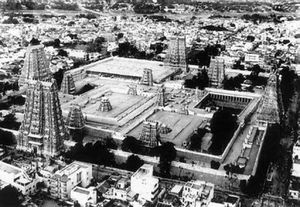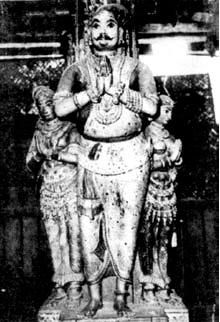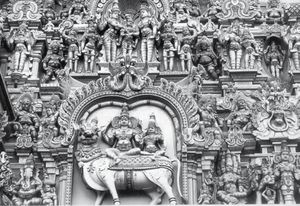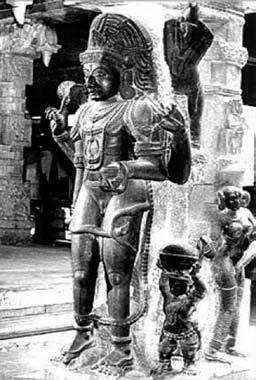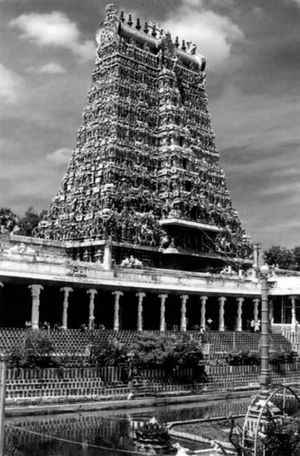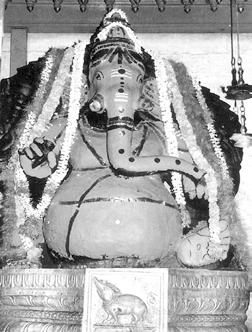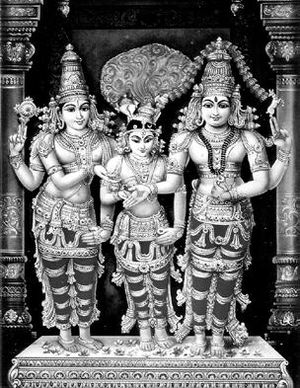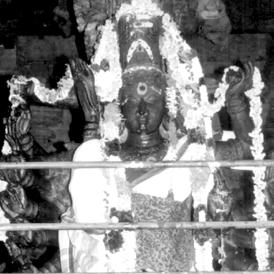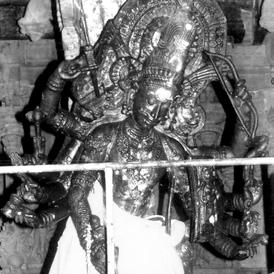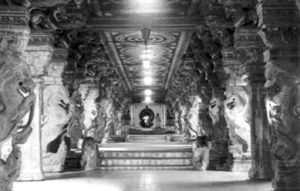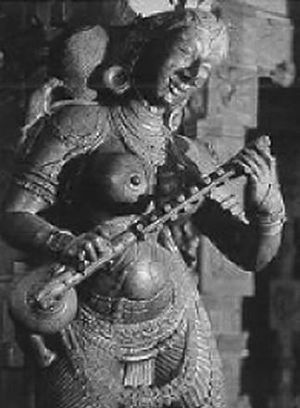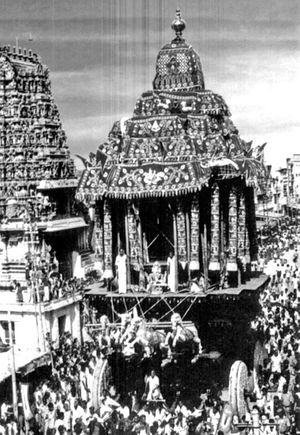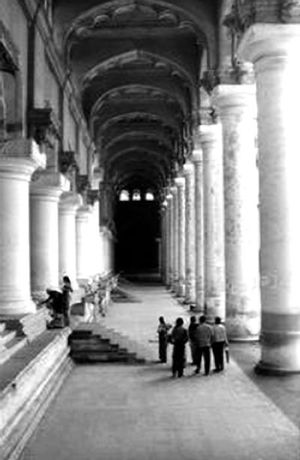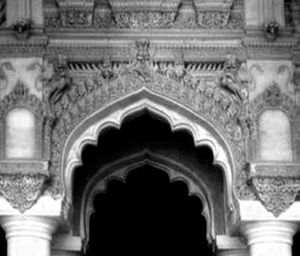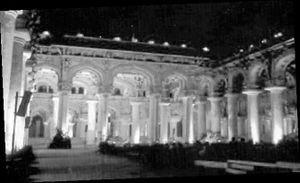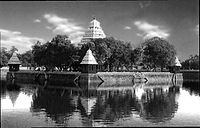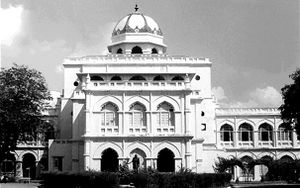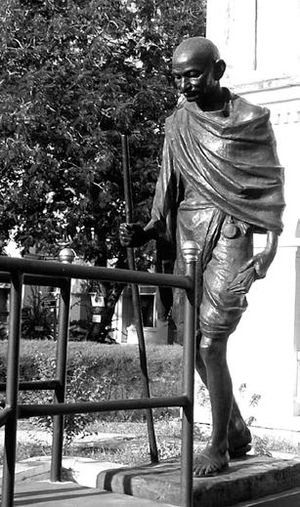Madurai
By N Hariharan
Madurai is congested, dusty, and noisy, but behind the facade of cacophony and grime lurks the real Madurai—glorious, grand, and hoary. It has a unique place on the map of Tamil Nadu and a special niche in Tamilians’ hearts. The city’s global renown draws tourists in droves while it bursts at its seams with a population of 1.5 million. Though Madurai is a multifaceted gem of a city—it is and has always been an important centre of political, economic, social, and cultural activity—it is its cultural dimension that dominates and overshadows the other aspects. It can rightly be called Tamil Nadu’s cultural capital. Standing on the banks of the Vaigai River, this beautiful city had been celebrated as the seat of Tamil learning and culture since ancient times. Its glory returned, though in a diminished form, in the earlier part of the last millennium. Present-day Madurai is spread over 22 square kilometers. The climate is tropical and the main spoken languages are Tamil, English, and Saurashtra.
Madurai is one of the oldest cities of India with a history dating all the way back to the Sangam period. Later on, after its ransack by the ravaging armies of Delhi’s Mali Kafue, it came under the rule of the Vijayanagara kingdom. During the sixteenth and eighteenth centuries, the city was ruled by the Nayaka kings, the foremost of whom was Tirumalai Nayakar. The Sangam poet Nakkirar is associated with some of the Tiruvilayadal episodes of Lord Sundareshvarar, divine sports of Lord Shiva, which are enacted as part of temple festival traditions even today.
It was on the fecund literary soil of Madurai that the sturdy tree of Tamil literature had its luxuriant growth. The Sangam era, early in the first millenium, was the golden age of Tamil literature. It witnessed a veritable literary efflorescence in the form of masterpieces. Madurai was already the seat of the Tamil Sangam, or academy of learning. Eminent poets and scholars of great renown adorned the academy and brought undying fame to it.
Madurai has also been a spiritual sanctuary. The Minakshi-Sundareshvarar temple is a hallowed spot from which spirituality radiates and rejuvenates Madurai’s citizens. The temple is the city’s best-known landmark. The layout of the city resembles a lotus with its petals encircling the central bud. The temple is the bud round which run the thoroughfares of Madurai in concentric circles. In fact, the rectangular series of streets reminds one of the structures of the cosmos. The majestic towers of the temple, visible from every corner of the city, ensure that no stranger loses his way here. The old city lies on the southern side of the Vaigai. The northern side has seen an exponential growth of new settlements and colonies and forms part of the new city.
In days of yore, Madurai was also a commercial centre, having trade links with places like Rome and Greece. It was visited by Megasthanes as early as the third century BCE. Under the able rule of the Pandyas, the city flourished until the tenth century BCE when it was captured by the Cholas, their archrivals. The Cholas ruled Madurai from 920 BCE till the beginning of the thirteenth century CE. In 1223 the Pandyas regained their kingdom and the city once again became prosperous. Tamil came to enjoy immense patronage, and it was during the Pandya reign that many masterpieces of that language appeared.
Silappadikaram, the great Tamil epic, is based on the story of Kannagi, who burnt down Madurai to avenge the injustice caused to her husband Kovalan. In April 1311, Malik Kafur, the general of Delhi’s Aladdin Khalji, raided Madurai and plundered the city of precious stones, jewels, and many rare treasures. This was followed by a spate of attacks and raids by other Muslim rulers, and in 1323 the Pandya kingdom became a province of the Delhi Empire under the Tughluqs.
Madurai was a prize city that attracted the covetous glances of greedy kings. In 1371 the rulers of Hampi captured Madurai and it became part of the Vijayanagara empire. The Vijayanagara kings used to entrust the administration of captured territories to governors called Nayakas to ensure efficient management of the empire. The Nayakas paid an annual tribute to the Vijayanagara empire. After the death of Krishnadeva Raya in 1530, the Nayakas became independent and ruled the territories under their control. The most popular among them was Tirumalai Nayakar (1623–59), who is even now fondly remembered by the citizens of Madurai for the creation of many magnificent structures in and around the city. The Raja Gopuram of the Minakshi Amman temple, the Pudu Mandapam, and the Tirumalai Nayakar Mahal are an eloquent testimony to his artistic zeal.
Then occurred a turning point in Madurai’s history. It began to slip into the hands of the British East India Company. In 1781 the British appointed their representatives to look after Madurai; George Procter was the first collector. Be that as it may, a prominent name that figures in the history of Madurai is Rani Mangammal, a woman of great sagacity and administrative ability. Though women were generally believed to be unsuited to the exacting tasks of governance, Rani Mangammal shines as an example of an efficient and strong ruler.
Madurai is justly famous for its temples. Besides the Minakshi Temple, the Tiruvappudaiyar Koyil Thevara Sthalam and the Kudalalagar Divya Desamare the most important temples. In the vicinity of Madurai is Tirupparamkunram, one of the six Padai Vidu shrines of Sri Murugan glorified in Nakkirar’s Tirumurugatrupadai. Two other Divya Desams, Alagarkoyil and Tirumohur, are also in the neighbourhood.
The Minakshi Temple[edit]
|
The Minakshi temple has a elegant three-storied gopuram facing the east, the main entrance to the temple. The approach to the temple is filled with a divine fragrance. The shops on either side of the street vend puja articles like flowers, garlands, coconuts, incense sticks, camphor, sandalwood paste, betel leaves, haldi, and kumkum.
The Minakshi shrine is one of the fifty-one Shakti Pithas and is hailed as the seat of Budha, Mercury. It is one of the Pancha Sabhas, or Five Halls, of Lord Nataraja and is celebrated as the Velli Ambalam or Rajata Sabha where the Lord Shiva performed his mighty tandava dance for the sake of his devotees Patanjali and Vyaghrapadar at the time of his wedding with Goddess Minakshi. Devi Shakti had incarnated Herself as a Pandyan princess and married Lord Shiva. The glory of Minakshi-Sundareshvarar has been extolled in immortal hymns by the Shaiva saints Appar, Sundarar, Tirujnanasambandhar, and Manikkavachakar, and in the works of erudite scholars like Paranjyoti Munivar, Kumara Guruparar, and Nilakantha Dikshitar.
According to some ancient texts, Madurai was earlier known as Halasya Kshetram, Kadamba Vanam, Tiru Alavoi, and Jivanmukti Nagaram.
Origins[edit]
Centuries ago, Madurai was a forest of kadamba trees. Once Indra, king of the Gods incurred the sin of killing a brahmana. In order to wash off the sin, he went on a pilgrimage. When he was roaming in this forest, he stumbled on a svayambhu linga under a kadamba tree. He performed severe penance there and felt thoroughly purified. He worshipped the linga with golden lotuses from a nearby tank, built a vimana over it, and returned to heaven. Since then, the gods started worshipping the linga. One day, a merchant byname Dhananjayan happened to spend a night near the shrine. He felt as if regular puja was being per formed there. He apprised Kulashekhara Pandyan, king of Manavur, of the matter. At the same time, Lord Shiva, with honey dripping from his matted locks, appeared to the king in dream and commanded him to build shrine there. The king hastened to the forest and offered worship to the linga, now encircled by a large serpent. Then he had a proper shrine built there and developed around it the city of Madurai in the shape of a lotus. Thus Madurai became the famous capital of the Pandyas.
Kulashekhara was followed by Malayadhwaja. Malayadhwaja and his wife Kanchanamala were childless. In the course of one of the many yajnas that the royal couple performed in order to get child, they were overjoyed to see a girl child emerge from the sacred fire. The child was named Tadatagai. But the girl had a queer appearance with three breasts. A disembodied voice, however, assured the worried king that the girl’s third breast would disappear the moment she set her eyes on her future husband. Tadatagai grew up to be a heroic woman well versed in the science of warfare, and in course of time succeeded her father to the throne. Now she set out on an expedition of conquest and brought the neighboring kingdoms under her rule. Her triumphant march eventually took her to Mount Kailas, the abode of Shiva. A miracle happened on the battlefield as she confronted Shiva. Shiva’s gaze made her shy and, lo, her third breast disappeared! Shiva promised to marry her at Madurai—so Tadatagai was none other than Devi Parvati—and she returned to her capital. In due time, the wedding of Shiva and Tadatagai took place and together they ruled Madurai for some time. A son named Ugra Pandyan, an incarnation of Murugan or Subrahmanya, was born to them. After crowning him as king, the couple assumed their divine forms and took their lodgement in the temple. That is why the images in the Madurai temple look so infused with divine power and radiate spiritual splendour.’
Architecture of the Meenakshi Temple[edit]
The origin of the temple fades into the mists of antiquity. Only a small shrine of Shiva existed in the seventh century CE. The Minakshi temple was built in the twelfth century. It represents the high-water mark of Tamilian architecture. The sculptural marvels that abound in the temple towers and the beautifully chiseled mandapams are a standing testimony to the skills of Tamil artisans. Of the eleven gopurams towering over the temple, the four nine-storeyed ones at the four main entrances are noteworthy. These were built between the thirteenth and sixteenth centuries. The oldest is the east tower built by ManavarmanSundara Pandyan in the thirteenth century. The tallest and most imposing is the south tower rising to a height of 170 feet with its parabolic curve; it was built by Sevvantimurti Chettiar of Siramalai in 1559. The western tower was built by Parakrama Pandyan in the fourteenth century. Though of massive size, these towers look like exquisite ornaments studded with gems in the form of hundreds of sudhai statues—colourful images of gods, goddesses, animals, and mythical figures.
The five musical pillars, each consisting of twenty-two smaller pillars carved out of a single stone and producing different notes when struck, are another great attraction for visitors. The sprawling temple complex also consists of several mandapams. These are not just a chaotic jumble of jaded structures that pass off as mandapams, but well-planned halls that are artistic treasure-troves.
Since Goddess Minakshiis the presiding deity here, devotees enter the temple through the Ashtashakti Mandapam, or Abode of the Eight Powers. Look at that lovely sculptural representation of Minakshi’s wedding there over the entrance to the mandapam. See also the images of Ganesha and Subramanyan installed on either side. The eight Shaktis are Kaumari, Raudri, Vaishnavi, and Mahalakshmi on the left and Yajnarupini, Shyamala, Maheshwari, and Manonmani on the right. How attractive they look! Besides these, there are dvarapalakas, or guards, in front, and statues of Ganapati and Murugan. Aren’t the wall paintings so lovely! They graphically depict interesting scenes of Shiva’s miracles from Paranjyoti Munivar’s Tiruvilayadal Puranam, which is regarded as the sthala purana (local legend) of the Madurai temple. The four figures adorning the eastern side are the four great Shaiva saints Tirujnanasambandhar, Tirunavukkarasar, Sundaramurty Nayanar, and Manikkavachakar. The Ashtashakti Mandapam was built by Rudrapati Ammai and Toliammai, the consorts of Tirumalai Nayakar. Here food used to be served to pilgrims who came from far-off places. Now you see fruit stalls on both sides of the building.
A small mandapam with verandas running along either side connects the Ashtashakti Mandapam and the Minakshi Nayakan Mandapam. On the southern veranda, there is an eight-foot-high statue of Goddess Parvati. She is dancing with a shulayudham, a kind of spear, in one hand and resembles a huntress. A five-headed serpent shields her against sun and rain. On the northern veranda is a statue of a hunter. This is also eight feet high and is thought to represent Shiva as a hunter.
The Minakshi Nayakan Mandapam, named after its builder; it is also called Yali Mandapam. The structure is 160 feet long and 110 feet wide. Here we see before us six rows of 110 pillars, each 22 feet high. Every pillar bears the figure of a yali, a strange creature half lion and half elephant, at the top, and fascinating sculptural patterns at the bottom. At the western end is a massive 25-foot-high tiruvatchi containing 1,008 brass lamps! The array of lamps, when lighted, presents a magnificent sight. The tiruvatchi was installed by the Marudu Pandyas, and its maintenance costs are even today met by the Shivagangai estate’s hereditary trustee.
On the way to Amman Sannidhi, or Mother’s Presence, there is a seven-storeyed tower whose base is 78 feet long and 38 feet wide. The height of the tower is 177 feet. The tower is resplendent with 730 fine sculptures. It is called Chitra Gopuram, or Marvellous Tower. The tower can be seen from the Adi Vithi, the first circular street around the Minakshi-Sundareshvarar shrines, at the spot where elephants are tethered, or from the western side of the Golden Lily Tank. Kalatinatha Mudaliar, son of Dalavoi Ariyanatha Mudaliar, built the tower in 1569. It is now maintained by the Shivagangai Devasthanam.
The Mudali Pillai Mandapam, also known as the Dark Mandapam is next. This 60-foot-wide structure was built by Kadantai Mudaliar. Of the myriad carvings here, the telltale figures of Bhikshadanar, the wives of the Darukavana sages, and Mohini are the most arresting. An interesting story is associated with the lovely women represented in these sculptures. Once the wives of the sages of Darukavana fell in love with Shiva when he appeared before them in the form of a bhikshadanar, or mendicant. His beauty so bewitched them that they stood mesmerized, unaware even of their garments. A connoisseur cannot but wonder at the way the sculptor has lavished all his skills on these statues. The statue of Bhikshadanar is true-to-life, evocative, and fully reflects the sculptor’s artistic abilities. Images of Ganesha and Subrahmanya are also found in this mandapam. The term ‘Dark Mandapam’, however, is now a misnomer, as the building is now well lit and ventilated by windows.
Golden Lotus Tank[edit]
The Potramarai Kulam, or Golden Lotus Tank is a large reservoir with stone steps on all four sides and a wide corridor running around it near the entrance to the temple. There is a golden lotus floating at the center of the reservoir. According to history, Indra once bathed here to rid himself of his sins. He collected golden lotus flowers from the tank and worshiped Shiva with them. The tank is 165 feet long and 120 feet wide and remains full for the best part of the year; it is hardly ever dry. Devotees wash their feet—and their sins, à la Indra!—in the pellucid water before entering the temple.
From the middle of the eastern corridor, two small towers covered with golden plates can be seen in the midst of the eight temple towers. The chief deities, Minakshi and Sundareshvarar, are ensconced in sanctums below these golden towers. The wall of the southern corridor is inlaid with marble slabs engraved with 1,330 couplets from Tiruvalluvar’s Tirukkural. The numerous pillars in the northern corridor bear the figures of twenty-four poets of the third Tamil sangam, but on one of them there is the Kulashekhara Pandyan and on another is Dhananjayan. Bright, colourful paintings on the ceilings of all the corridors depict scenes from the Tiruvilayadal Puranam. It is said that in the olden days the literary worth of a Tamil work was tested by placing it on a plank on the water of this tank. If it floated, it was deemed worthy, and if it sank, well, it sank!
The Unjal Mandapam is a hall built in black marble with an unjal, or swing, on the western side of the tank. Every Friday, the gold images of Minakshi and Sundareshvarar are placed on the swing, gently rocked to the accompaniment of music, and worshipped. The paintings on the ceiling of this mandapam portray Subramanian’s Arupadai Vidu, or Six Abodes. That smaller mandapam on the opposite side has paintings done during Rani Mangamma’s period.
The Kilikutu Mandapam, or Parrot cage Hall is where the parrots are kept. They are trained to call the name of Minakshi and are a great amusement amusement for the children. The hall’s grandeur is enhanced by the long row of 28 pillars and exquisitely carved sculptural pieces. Particularly noteworthy are the figures of Vali, Sugriva, the Pandavas, and Draupadi. A yali is engraved on another pillar; a ball of stone revolves in its mouth! There are also two large paintings of Minakshi’s wedding and coronation. Mural paintings on the ceiling are eye-catching. Opposite AmmanSannidhi, on one side of the balipitham, or sacrificial altar, is a pillar bearing the figure of Bhimasena, and on a pillar on the other side is a semi-human figure; both stand in combative poses. In this mandapam, the pillars depict Shiva’s miraculous deeds. The figures, though very small, are of unsurpassed charm. The paintings on the canopy represent an array of deities of the Hindu pantheon. The scene of Minakshi’s wedding in front of the Sannidhiis attractive.
The heart of the temple is the Devi’s sanctum. It has a three-storeyed tower at the entrance and is 40 feet high with the base 27 feet long and 20 feet wide. It is a repository of 476 exquisite sculptures. The tower is called Vembattur Tower after its builder Ananda Tandavanambi of Vembattur. On the outer prakaram, or circular corridor, can be seen the golden flag-post, the Tirumalai Nayakar Mandapam, brass dvarapalakas, and the shrines of Vinayakar and Kudal Kumarar. That is the Kolu Mandapam in the western corner. During the Navaratri festival in the Tamil month of Purattasi, in September-October, the image of Minakshiis exquisitely adorned in nine different ways on the nine days and kept there for public view and worship.
To the west is a bigger, five-storeyed tower. This is 54 feet high and its base is 50 feet long and 28 feet wide and is visible even from the western Adi Vithi. The imposing structure has 224 impressive sculptures. At the south-west corner of the inner prakaram is the Vinayakar shrine and at the north-east junction stands that of Kudal Kumarar. Stanzas of the Tiruppugal sung by the saint Arunagirinathar are inscribed on the walls of this shrine.
To the east there is an entrance to Swami Sannidhi. One can reach the Mahamandapam or inner prakaram through the Arukal Pitham. This is where the Shaiva saint Kumara Guruparar sang his “Meenakshi Ammai Pilai Tamil”. The story goes that the goddess was so delighted with the hymns that she appeared before the saint in the form of a small girl and gifted him a pearl necklace. The Arukal Pithamis also the venue of Devi Minakshi’s coronation during the Chitrai festival. The shrines of Airavata Vinayakar and Muttukumarar, and the Palli Arai or Chamber of Repose, can also be seen in the Mahamandapam. Its pillars and ceiling (all made of stone) have exquisite pieces of sculpture—for instance that bell hanging from the top. To the west are the Ardhamandapam and the sanctum sanctorum.
In the center of the sanctum is the Goddess Minakshi and a long queue for devotees to get darshan is in front of her. The Mother is dressed in splendid finery and sparkling jewelery. She exudes a sublime grace and charm she as she stands holding a parrot and a bouquet in her hands! Her fish-shaped eyes brim with tenderness, compassion, love. Mother has the power to bestow all-round welfare on us by a mere glance of those eyes. Just as the mother fish hatches her eggs by lovingly gazing at them, Mother Minakshi vitalizes and nourishes her children by casting her benign glance on them.
Past the sanctum is the shrine of Lord Sundareshvarar. On the way towards its entrance, there is a colossal statue of Ganesha. The statue is eight feet tall. However, Vinayakar, seated on a high pedestal, looks equally compassionate. This image is known as Mukkuruni Vinayakar. It was found when Tirumalai Nayakardug the Vandiyur Mariamman Teppakulam. It faces the south, as if to welcome the devotees. On the sacred Vinayaka Chaturthi day, a big kozhukkattai, a ball of rice mixed with sugar and coconut, made from three kurunis (equivalent to 34 kilograms) is offered to the god, so the name Mukkuruni Vinayakar.
The outer prakaram is 420 feet long and 310 feet broad while the inner prakaram is 250 feet by 158 feet. West of this is a five-storeyed tower, built in 1374 by one Mallappan. It is 72 feet high with a base measuring 48 feet by 31 feet. There are 40sculptures on this tower.
The next corner is where the figures of the forty-nine poets of the kadai, or last, sangam lie. North of this is a mandapam where weekly group prayers are held. Adjoining this is a five-storeyed tower, built by Sevantivelappa Chettiar in 1560. It is 71 feet high with a base 45 feet long and 34 feet wide. This tower has 18 sculptures. At the top of the tower can be seen the majestic figure of a vrishabha, or bull, Shiva’s mount.
The mandapam at the north-eastern corner as seen from the corner with the poets is the main mandapam and is supported by 100 pillars. It too contains some fine pieces of sculpture. A lovely murthy of Nataraja is installed there. The mandapam was built by Chinnappa Nayakar in 1526. At the south-eastern corner is the Jnanasambandhar temple. Here there are statues of Mangayarkarasi, Kulachirayar, Kunpandyan, Sambandhar, Appar, Sundarar, and Manikkavachakar. This mandapam was built by Krishnavirappa Nayakar.
Beyond this, in the outer prakaram in front of Sundareshvarar shrine is another large and spacious mandapam, its pillars embellished with images of surpassing beauty. This is the well-known Kadambatadi Mandapam. A veritable treasure trove of sculptural riches. Each one of the sculptural pieces and the architecture of the building as a whole is a feast for discerning eyes. See that golden flagstaff, Nandi, and the balipitham at the centre. The intricate sculptural carvings on each of the eight ornamental pillars depicting Shiva’s different manifestations: Ardhanarishwarar, Dakshinamurty, Rudrar, Bhikshadanar, Lingodbhavar, Vrishabharudrar, Somaskandar, Ekapadamurty, Chandrashekharar, Natarajar, and Somasundarar. There are also the ten incarnations of Vishnu.
The Celestial Wedding[edit]
The sculpture depicting Meenakshi’s wedding is a striking example of Tamilian temple art. The colossal statues of Agni Virabhadra, Aghora Virabhadra, Kali, and Shiva are close by. The scene, captures the sublime solemnity of Vishnu’s offering of his sister Minakshi in marriage to Sundareshvarar is enthralling. The sculptor has distilled profound moods with the subtle nuances of his creation! While bridal shyness oozes through the figure of Minakshi with her slightly bent head, Sundareshvarar, with His benign smile, exudes at once masculine charm and deep self-possession, while Sundararajar, as Vishnu is called, moves us by his look, reflective of joy not unmixed with a tinge of pain of impending separation from his sister.
There is a nearby cluster of pillars that depict scenes from the Purana-s. On one pillar stands a formidable Shiva, ensconced in a chariot and ready to mount an attack on the demons on the opposite pillar. It represents the story of Shiva’s awesome fight with the demon Tripura. With a view to storming the three magic cities of the demons and destroying them, Shiva made earth his chariot and rode into the battlefield. The sun and the moon were the wheels of the chariot; the four Vedas were the horses, and the Upanishads the reins. Vishnu himself became Shiva’s terrible bow. Thus equipped, the god destroyed Tripura’s three impregnable fortresses, made of iron, silver, and gold.
Another pillar illustrates the story of the great devotee Markandeya. According to a Puranic story, Shiva saved his devotee from death by kicking Yama with his left foot! And on the other one is Nataraja. Another has a network of designs detailing the incident of Shiva’s burning of Manmatha, Cupid.
There is another that contains the scene where Ravana caught under Mount Kailasa with Parvati-Parameshvara, sitting on top of the mountain. Ravana was a great devotee of Shiva. Once, in his impudence, he dared to lift the mountain, the abode of his chosen deity. But Shiva humbled him by pressing his toe on the mountain, which bore down on Ravana, causing him to wail aloud. Ravana was released only after pacifying Shiva by playing on his lute and singing sama chants.
Another pillar contains a sculpture of a column of light and a boar and a swan. The column of light was the form Shiva assumed in order to curb the pride of Brahma and Vishnu, who had fallen into a dispute as to who was greater between the two,’Selvi explains. ‘Emerging from the linga as Lingodbhavamurti in the form of a massive pillar of effulgence, Shiva declared that the one who found either the top or the bottom of the pillar of light would be the greater of the two. Brahma promptly assumed the form of a swan and soared up to find the top, and Vishnu took the form of a boar and burrowed through the nether-worlds in search of the bottom. However, both were unsuccessful in their attempts. But while Vishnu humbly admitted his failure, Brahma falsely claimed to have seethe top of the pillar of light. He tried to buttress his claim by presenting as proof a petal of the ketaki flower, which he said was taken from Shiva’s matted locks. Enraged by Brahma’s falsehood, Shiva cursed him that he would never receive temple worship and that the ketaki would no more be used in Shiva worship—as punishment for its complicity in the entire affair! The implication of the story is that Brahman, here represented by Shiva, can be realized neither by discursive knowledge, symbolized by Brahma, nor by material wealth, symbolized by Vishnu.
Shiva is sometimes represented in his peculiar dichotomous form, as Ardhanarishvara. One sculpture shows him with the left half of his body feminine and the right half masculine. Thus Purusha and Prakriti are combined in one form—but it also suggests that he is beyond both aspects. In another dichotomous representation on another pillar depicts the left side of the image as Vishnu in his silken raiment, with ornaments and weapons, while the right side depicts Shiva with his matted locks, his ash-smeared body clad in antelope skin. This is the Shankaranarayana form that strikes at the root of the supposed divorce between Shiva and Vishnu. And there is Shiva in his meditative pose; he is facing the south. Young in age but ripe in wisdom, he imparts spiritual knowledge to his four old disciples, the four eternal sages Sanaka, Sananda, Sanatana, and Sanatkumara, through mystic Silence. That is his Dakshinamurti form.
Another depicts Shiva killing an elephant in his Gajaharamurti form. The elephant was in fact a demon masquerading as a rampaging tusker and intending to kill Shiva, here shown as Bhikshadanar. The demon was set upon Shiva by the jealous sages of Darukavana, whose wives were carried away by the god’s beauty. On the next pillar are the figures of Bhikshadanar, Rudrar, Kiratarjunar, and Somaskandar. You can also see the ten avatars of Vishnu engraved at the bottom of some pillars. The carvings on this other pillar here feature a story in which Shiva helps an old woman on the banks of the Vaigai.
The inner prakaram begins with a big hall called the Velli Ambalam, or Silver Hall inside of which there are four immense statues: on the eastern side of the Kadambatadi Mandapam of Agni Aghora Virabhadrar and the awe-inspiring forms of Urdhva Tandavar (Nataraja) and Bhadrakali. These images reflect moods as fury and fortitude, resolve and ruthlessness. Agni Virabhadrar and Aghora Virabhadrar are bespattered with globs of butter because devotees throw butter at the frightful forms in order to pacify them. The Urdhva Tandavar statue is a form of Nataraja performing a rare type of dance with his right leg raised straight up so that it almost touches his right ear. Normally, Nataraja is portrayed with his left leg raised. The fact that the image is set in a silver enclosure gives this hall its name. It is also believed that Nataraja performed the rare jnanasundara tandavam here to please the devotee-king Rajashekhara Pandyan.
In front of the entrance to the sanctum sanctorum of Shiva's shrine, there is a two 12-foot-high dvarapalakas on either side. The images of Shiva and Minakshi have five faces each. There are also statues of the four saints Appar, Sundarar, Sambandhar, and Manikkavachakar nearby. Their lyrical outpourings in praise of the Lord in chaste Tamil are known as the Tevaram, or “A Garland for the Divine”. There is also a three-storeyed tower of Swami Sannidhi. It is 41 feet high with a base 31 feet long and 18 feet wide and contains 36 sculptures. It was built by Kulashekhara Pandyan in 1168. The sanctum itself is a quadrilateral structure with artistic engravings of sixty-four bhuta ganas (Shiva’s companions), eight elephants, and thirty two lions. Nearby is the linga of Lord Sundareshvarar, also known as Chokkanathar and Karpurachokkar. It is installed under a golden canopy called the Indravimanam. The linga is an ingenious device that represents the two apparently contradictory aspects of the Godhead. As a tangible image it surely has a form, but being featureless it can be considered formless. It is, so to say, in the twilight zone between form and formlessness and admirably signifies the indefinability of the Infinite. Again, the linga is also a visual symbol of Om. It is believed to comprise the four deities Brahma, Vishnu, Rudra, and Shiva. The base of the linga is Brahma, the encircling portion is Vishnu, the cylindrical portion is Rudra and the crown is Shiva. The first three stand for the three mystic sounds a, u, and m respectively; Shiva is the amatra—unmanifest sound—underlying omkara (aum). So the linga is doubtless a true symbol of the Absolute.
The imposing statues of Adhikara Nandi, or Nandi the Authority, and Chamundi are on a six-foot-high dais where Paranjyoti Munivar’s Tiruvilayadal was formally released. The copper coverings on the dais were gifted by Tirumalai Nayakar. The figures of Patanjali and Vyaghrapadar with folded palms carved are on the pillars facing the dais.
This prakaram abounds in attractive sculptures depicting the Shiva lilas. On the southern side we find a row of images of the sixty-three Nayanmars; there is also an image of Saraswati. At the southwestern corner is the utsava murti, which is used for processions during festivals, and at the north-western corner are the images of Kashi Vishvanathar and Bhikshadanar. On the northern prakaram, there is an image of the bearded Siddhar facing the east. Next to him stands Durga on an elevated pedestal, facing the north. The legendary kadamba tree with its preserved trunk still stands. And towards one corner, the "yaga shala and a well beside a vanni tree can be seen. In this corridor there is also an opening leading to a tunnel, which once upon a time led to Tirumalai Nayakar’s palace. The royal family used to come to the temple through this path. The tunnel also served as a secret vault to store valuable temple ornaments during times of attack.
The inner prakaram begins with the Velli Ambalam, or Silver Hall whose hallmark is the Urdhva Tandavar (or Nataraja dancing with his right leg raised). There are four other halls in the temple—Kanaka Sabha and Ratna Sabha in the first corridor, Deva Saba in the Hundred Pillar Hall, and Chitra Sabha in the Thousand Pillar Hall—but they are of minor importance compared to Velli Ambalam.
The five storeyed tower on the eastern side of the Kadambatadi Mandapam is 66 feet high with the base 42 feet long and 33 feet wide. It has 280 sculptures on it and was built in 1372 by Vasuvappan. To the east, beyond this tower, is another big Viravasantarayar Mandapam. It was built by Tirumalai Kayaker’s elder brother Muttuvirappa Nayakar. It has 46 pillars. The eyes of the big Nandi statue in front are fixed on his master Sundareshvarar. Some of the pillars here are studded with fine sculptural pieces depecting stories from the Purana-s, like Shiva’s rescue of Markandeya from Yama. The dancing Bhadrakali and the dvarapalakas are very popular. The tall arch of lights was donated by the Marudu Pandyas; the lights are maintained by the Shivagangai Devasthanam. There are rows of shops on both sides selling puja articles, bangles, brassware, etc.
Adjoining the Viravasantarayar Mandapam is the Thousand Pillar Mandapam which was built in 1569 by Dalavoi Ariyanatha Mudaliar. It originally had 1,000 pillars, but now there are only 985. The missing pillars were most likely removed to make space for two small temples in the hall. This mandapam is 250 feet long and 240 feet wide. It has been built to look like a huge chariot drawn by two elephants. Look at that figure of a wheel at the top of the entrance; see how graphically the features of the sixty Tamil years are described there! At the entrance is the majestic Ariyanatha Mudaliar on a horse, and the statue of Kannappan Nayanar close by. Kannappa was such an ardent Shiva bhakta that he did not hesitate to gouge out his own eyes and offer them to the Lord! Then come the statues of Satya Harishchandra and his wife Chandramati (with her holding her dead son in her arms). And over here are the well-known gypsy couple Kuravan and Kuratti. Their stone figures show their rugged physical features, poverty, and their travails; as well as the monkey on a leash and the couple’s unruly children. Another figure is of a stern-faced, resolute Shiva trampling a demon beneath his feet. He has an ineffable smile on his lips and the profound quiet of his face.
The other creations on the pillars of this mandapam are a woman playing on a vina, Murugan riding his peacock, the figure of a eunuch, and the exquisite Rati, Manmatha’s consort. The images on the whole present a refined commentary on the science of erotics. Thus the Thousand Pillar Mandapam lays out a delightful sculptural repast to genuine connoisseurs. In the olden days, it also used to be the venue of the royal court.
Towards the south, there is an open area with a newly built mandapam that bears the name of a saintly queen who contributed a lot to the growth of Shaivism and Tamil. It is called Mangayarkarasi Mandapam. It houses statues of Mangayarkarasi, Kulachirayar, Kun Pandyan, and Jnanasambandhar. South of this is the Servaikarar Mandapam built by the Marudu Pandyas sometime in the mid-eighteenth century. We find the figure of the elder Marudu on the left pillar.
There is also an ornatre hall with a copper-plated roof which is known as the famous Tirukalyana Mandapam, or Marriage Hall. The wedding of Minakshi-Sundareshvarar is celebrated every year at the time of the Chitrai festival in this Mandapam. During April-May the entire city of Madurai goes delirious with joy. A spirit of devotion pervades the entire atmosphere as people from far and near converge on Madurai to participate in the festivities and experience the exalted mood they generate. The dias where the actual ceremony is performed and the black stone mandapam were built by Vijayaranga Chokkanathar. His figure can be seen carved on the first pillar on the southern side. On the southern and northern walls, attractive paintings within those big circles graphically depict the origin of the universe and its living beings. The hall measures 97 by47 feet, spacious enough to accommodate the devotees. There are wooden carvings and paintings on the top portion which contain the pictures of Vynagaram Venkatachalam Chettiar and Nagappa Chettiar, who built this mandapam.
To the south are the Muttuvirappa and Minakshi Nayakar Mandapams and to their south is the Adi Vithis which are the outermost streets around the temple but within its precincts. The temple elephants and camels are kept in the courtyard at the eastern end of the temple. Towards the west, along the southern Adi Vithi, are located the temple offices, library, the Tevaram School, Tiruppugal Sabha, Divanerikalagam, Panniru Tirumurai Manram, and Dandapani Tiruppugal Manram.
The grand south tower on is the tallest structure in the entire temple complex: it is 170 feet high, its base 108 feet long and 67 feet wide. It is bejeweled, as it were, with 1,511 exquisite sculptural figures. The top of the tower commands a panoramic view of Madurai city. The two giant yalis on both sides of the tower have eyes whose diameter is two and a half feet! The tower was built in the sixteenth century by Sevvanti Chettiar.
The western Adi Vithi on whose northern side are located the offices of the Shivagangai Devasthanam. The west tower is 154 feet high with a base 101 feet by 64 feet. It contains 1,124 sculptural pieces. It was built by Parakrama Pandyan, who ruled Madurai between1315 and 1347.
The northern Adi Vithi exudes the fragrance of Tamil devotional literature. It is here that the Tiruppugal Sabha and the Tiruvalluvar Kazhagam are situated. The Tiruppugal Mandapam was built in 1952. The Tirukkural Kazhagam, housed in a beautiful mandapam, was started in 1941 by Tirukkural Attavadanam T P Subramania Das. This building is the venue of many religious meetings. The northern tower is bald and looks incomplete which is why it is called Mottai Gopuram, or Bald Tower-however, it does contain some sculptural work on it. This nine-storeyed tower was built by Krishnavirappa Nayakar during 1564–72. It stands 152 feet high on a base 111 feet long and 66 feet wide. To its west is the temple of Mottai Gopura Muniyandi. The deity is worshiped mainly on Tuesdays and Fridays. On those days the northern tower is decorated with thin flower garlands.
Beyond the north tower on the Adi Vithi stand five stone pillars. Each pillar has been carved out of a single stone and each contains within it more finely crafted pillars. These little pillars resonate when the outer pillar is struck and produce musical sounds.
The eastern Adi Vithi is a 16-pillared mandapam at the head of the street called Tattu Chutur Mandapam. It was built in 1772 by Venkateshwara Mudaliar and has paintings portraying the story of Manikkavachakar. The Swami Sannidhi is to the east and to its east is the east tower. This is the oldest of the big towers. Since it was built by Maravarman Sundara Pandyan, who reigned from 1216 to 1236, it is also called Sundara Pandyan Gopuram. It is 153 feet high with a base 111 feet by 65 feet, and has 1,011 sculptures on it.
On East Chitrai Street there is a small temple to the south of the east tower named Madurai Viraswami temple. Opposite that is the famous Pudu Mandapam which houses all kinds of shops.
Festivals[edit]
Madurai is a city of festivals. The grandest is the Chitrai. The highlights of this ten-day festival are Goddess Minakshi’s coronation, her wedding with Sundareshvarar, and the car festival (ratha yatra). A great flower-bedecked chariot bearing the utsava murtis of the divine couple is drawn by crowds of fervent devotees along the four Masi streets around the temple. The gold image of Alagar, or Sundararajar—the presiding deity of the hill shrine of Alagarkoyil, 20 kilometres away, who is supposed to be the goddess’s brother—is brought in procession to the Vaigai River to witness the wedding. Alagar’s reaching the Vaigai is believed to be such a sacred event that it draws lakhs of devotees. Fairs are also organized on the occasion. The grand festival comes to a climactic close on full-moon day of Chitra.
Madurai Meenakshi, Kanchi Kamakshi, and Kashi Vishalakshi are three forms of the Divine Mother and as such, Navaratari, is celebrated at the temple with great pomp. This too is a ten-day event marked by tremendous religious fervour. Kolus, galleries of colourful dolls of various sizes arranged in an imaginative manner, are specialty of this festival. The kolu in the temple is set up in the in inner corridor of Mother’s shrine on the southern side. Mother’s image shines prominently among the dolls, and she is decorated in ten different ways during the ten-day period. The inner significance of the kolu is that the Divine Mother is the benign Empress of the entire universe, and all living beings are her happy subjects.
Vasantotsavam and Avani Mulam are two other noteworthy religious occasions. During the latter, Shiva’s tiruvilayadals are enacted. It also features a car festival. Other major festivals include the Teppam (Float) Festival, Arudra Darshanam, the Tiruppavai-Tiruvembavai festivals and Mahashivaratri. The Float Festival commemorates the birth anniversary of Tirumalai Nayakar. A brightly lit float carrying the utsava murtis of Minakshi-Sundareshvarar goes round the illuminated Vandiyur Mariamman Teppakulam and is witnessed by thousands of devotees.
Every year, on the Vijaya Dashami day, a magnificent expression of devotion takes place at Sri Minakshi Temple: 108 veena artists assemble to dedicate a congregational recital to Mother Minakshi. The recital lasts a couple of hours, and is held in a massive temple hall accommodating several hundred people. Furthermore, every Friday evening, a veena artist performs at the temple. It is a unique and meaningful way of saluting the Goddess—the source of all vidya.
Tirumalai Nayakar Mahal[edit]
The Tirumalai Nayakar Mahal is just two kilometres south-east of the Minakshi temple. This palace was built by Tirumalai Nayakar in 1636 and it was here that he lived. Although large portions of the building were destroyed by his grandson when he shifted the capital to Tiruchi, its attraction remains undiminished.
A classic example of the Indo-Saracenic style, the pièce de résistance of the Mahal is its carved dome that soars above the rest of the palace without the support of girders or rafters—a truly outstanding architectural feat for those days. The stuccoed domes and arches, the huge pillars—there are 248 of them, each 58 feet tall and 5 feet in diameter—the paintings and carvings, and the overall design of the Mahal speak volumes about the Nayaka kings’ flair for architecture. The furniture and utensils used by them can still be seen inside. The courtyard and the dancing hall are the centers of attraction. Besides the royal residence, the sprawling palace also has a shrine—the king used to celebrate major festivals in the palace—an armory, and gardens.
A visitor can view the Kudalnagar temple from inside the Mahal, thus enjoying the double benefit of savoring the beauty of the palace plus having the darshan of the sacred temple at the same time. Nowadays visitors are treated to light-and-sound shows depicting the popular Silappatikaram story of Kannagi and Kovalan in both Tamil and English.
Vandiyur Mariamman Teppakulam[edit]
The Vandiyur Mariamman Teppakulam is a vast artificial lake five kilometers east of the Minakshi temple. It has a small mandapam in the middle which has an image of Vighneshwara inside. It is said that the rare image was discovered when the place was being dug up in order to supply building materials for the Tirumalai Nayakar Mahal. The lake is fed by the waters of the Vaigai through an ingenious system of underground channels.
Gandhi Memorial Museum[edit]
The Tamukkam Palace, which is now home to the Gandhi Memorial Museum is one of Madurai’s modern landmarks. This place is a living memorial to the father of India. Its generally agreed that the building was built by the Nayaka queen Mangammal around 1670. Soon after Mahatma Gandhi’s assassination in 1948, the Gandhi Memorial Trust appealed to the people of India to donate funds for a suitable memorial to the fallen hero. The response was so overwhelming that the Trust allocated 10 million rupees for setting up Gandhi Memorial Museums in seven selected places across the country associated with Gandhiji’s life. In 1955, the Madras state government gifted the Tamukkam Palace and 13 acres of land to the Gandhi Smarak Nidhi for building the museum in Madurai since Gandhiji visited Tamil Nadu fourteen times! Madurai is associated with certain momentous incidents in his life. It was here in 1921 that Gandhiji adopted his trademark dhoti-chadar dress; this sartorial style of his eventually earned for him the sobriquet “the half-naked fakir”. And it was here that he achieved a historic triumph over untouchability: in 1946, he embarked on a relentless campaign that dealt a death blow to this social evil and ended with the doors of the Minakshi temple being thrown open to the Harijans.
It contains a picture gallery presenting a visual biography of Mahatma Gandhi by means of paintings, photographs, quotations, and photocopies of his important letters. The museum also has special exhibitions on the Indian freedom movement, khadi and village industries, and handicrafts. There is also a hall where some of Gandhiji’s personal belongings are preserved.
Towards the south of the building, there is a big open-air theater that can accommodate 8,000 people. Cultural events, weekly film shows, and public meetings are held there.
From there the girls move on to the Gandhi Kutir, a replica of Gandhiji’s cottage in Sevagram, in front of the museum. The north wing of the museum contains a large library. It has 20,000 volumes, mainly books on and by Gandhiji and allied literature.
Ramakrishna Math[edit]
The Ramakrishna Math is located to the north of the Vaigai. In a spiritual sense, this Ramakrishna temple is no less than the Minakshi temple! Both are mighty centers of energy ministering to the spiritual needs of the people. Just as Mother Minakshi arouses our devotional instincts, Sri Ramakrishna, Sri Sarada Devi, and Swami Vivekananda inspire with their life-giving messages. Together, they form a bulwark of Sanatana Dharma and Vedanta against mindless materialism.
The Ramakrishna center is of very recent origin—it came into in 1975. However, from its humble beginnings as a private center run by dedicated devotees it has steadily grown in stature and blossomed into a full-fledged institution providing a wide range of services to the local people.
Sri Ardhanari and Dr Shanmugam, one a merchant and the other a reputed surgeon, were the instruments Sri Ramakrishna chose for his work in Madurai. These two genuine devotees pooled their resources to start the private center and served visiting swamis wholeheartedly. Thanks to their labor of love the center was affiliated to the Ramakrishna Math in 1987.
This temple was consecrated by Srimat Swami Ranganathanandaji Maharaj, the thirteenth president of the Ramakrishna Order, on 13 March 1998. Besides daily worship and bhajans in the temple, the center also holds weekly religious classes and monthly spiritual retreats in its spacious auditorium. It also runs a primary school, a free coaching center, a charitable dispensary, a library, and a bookshop. Furthermore, its monks and devotees are constantly engaged in serving poor and needy people in various ways: for instance, every day some three hundred poor children are fed here.
Madurai Kamaraj University[edit]
In Palakalai Nagar is the famous complex of Madurai Kamaraj University. Until a few decades back, Tamil Nadu had only one university, Madras University. In view of the growing number of colleges in the southern districts, the state government felt it prudent to establish another university in Madurai. This was started in 1966, and the University of Madras Extension Center Library was renamed Madurai University Library. The city complex, however, soon proved inadequate for the university’s growing needs. So in 1973 it was shifted to its present location in Palakalai Nagar near Vadapalanji village on the Theni main road, 13 kilometres west of Madurai city. The foundation stone of the new complex was laid by President Dr Zakir Hussain. But it was only in 1978 that Madurai University got its new name Madurai Kamaraj University. The institution occupies a 753-acre area with the Nagamalai hills in the background.
Other Notable Places & People[edit]
Madurai has been visited by Sri Sarada Devi and Swami Vivekananda. This is where Bhagavan Sri Ramana Maharshi was born and attained spiritual illumination when he was a young boy. On a different level, in the sphere of classical music, some of the top-notch artists it has produced include the legendary M S Subbulakshmi, Madurai Mani Iyer, T N Sheshagopalan, G S Mani, and Madurai Somasundaram. Two cultural institutions, Sadguru Sangita Samajam and Tamil Isai Sangam, are doing great service in the field of fine arts, particularly Carnatic and Tamil music. The Lakshmi Sundaram Hall and Raja Muthiah Manramare two other prestigious auditoriums that serve as venues for cultural programmes.
References[edit]
- Originally published as "Madurai, The Legendary Temple City" by Prabhuddha Bharata February 2007
, March 2007
, April 2007
editions. Reprinted with permission.

